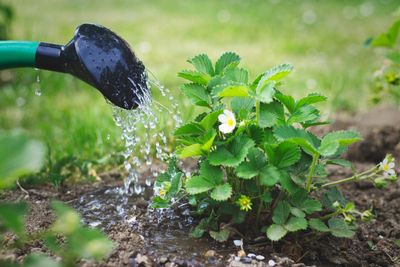Strawberry Water Needs
Strawberries tend to dry out fairly quickly because they are shallow-rooted plants with roots that exist mostly in the top 3 inches (8 cm.) of soil. Generally, there is no need to water strawberries if your climate receives around 1 to 1.5 inches (2.5-4 cm.) of rainfall per week. In drier climates, you’ll have to provide supplemental moisture, especially during hot, dry weather. As a general rule, figure about an inch (2.5 cm.) of water per week, although you may need to increase that amount to as much as 2.5 inches (6 cm.) during hot, dry summer weather. How do you know it’s time to water? It’s important to check the soil before you irrigate, which is easy to do by inserting a trowel or wooden stick into the soil. Wait a few days and check again if the top 2 inches (5 cm.) of soil is dry to the touch. Keep in mind that heavy, clay-based soil may need a little less water, while sandy, fast-draining soil may need more frequent irrigation.
How to Water Strawberries
Avoid overhead sprinklers when watering strawberries. Instead, use a drip irrigation system or a soaker hose at least 2 inches (5 cm.) from the plants. It’s important to keep the leaves as dry as possible, as strawberries are susceptible to rot in soggy conditions. Alternatively, you can let a garden hose trickle near the base of the plants. Early morning is the best time for effective strawberry irrigation. This way, the plants have all day to dry before evening. If you’re growing strawberries in containers, check the moisture daily; the potting mix will dry out quickly, especially during warm weather. It’s always better to water a little less than to overwater and create unhealthy, waterlogged soil. A layer of about 2 inches (5 cm.) of mulch for strawberries, such as straw or chopped leaves, will control weeds, conserve moisture, and prevent water from splashing on the leaves. You may need to limit mulch, however, if slugs are a problem. Also, be careful not to let mulch pile up directly on the stems, as damp mulch may promote rot and other moisture-related plant diseases.
